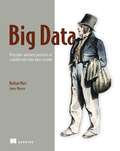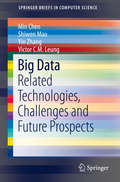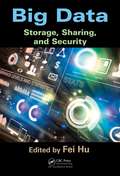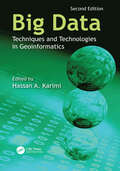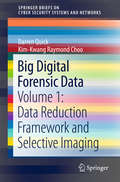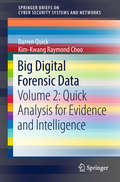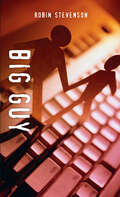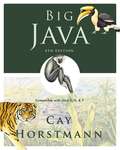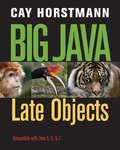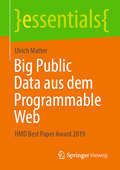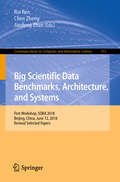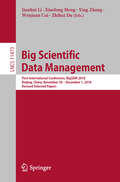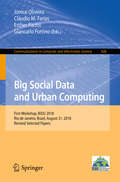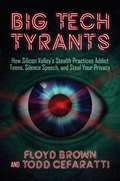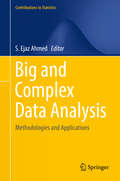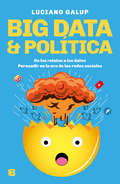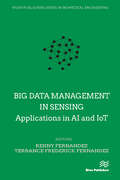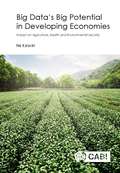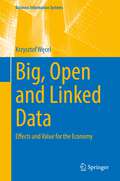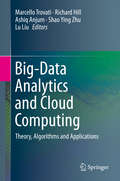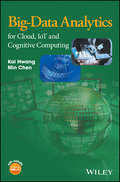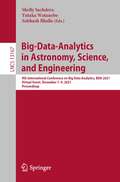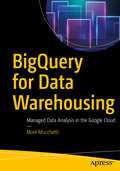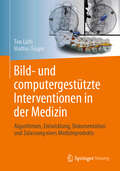- Table View
- List View
Big Data: Principles and best practices of scalable realtime data systems
by James Warren Nathan MarzSummaryBig Data teaches you to build big data systems using an architecture that takes advantage of clustered hardware along with new tools designed specifically to capture and analyze web-scale data. It describes a scalable, easy-to-understand approach to big data systems that can be built and run by a small team. Following a realistic example, this book guides readers through the theory of big data systems, how to implement them in practice, and how to deploy and operate them once they're built.Purchase of the print book includes a free eBook in PDF, Kindle, and ePub formats from Manning Publications.About the BookWeb-scale applications like social networks, real-time analytics, or e-commerce sites deal with a lot of data, whose volume and velocity exceed the limits of traditional database systems. These applications require architectures built around clusters of machines to store and process data of any size, or speed. Fortunately, scale and simplicity are not mutually exclusive.Big Data teaches you to build big data systems using an architecture designed specifically to capture and analyze web-scale data. This book presents the Lambda Architecture, a scalable, easy-to-understand approach that can be built and run by a small team. You'll explore the theory of big data systems and how to implement them in practice. In addition to discovering a general framework for processing big data, you'll learn specific technologies like Hadoop, Storm, and NoSQL databases.This book requires no previous exposure to large-scale data analysis or NoSQL tools. Familiarity with traditional databases is helpful.What's InsideIntroduction to big data systemsReal-time processing of web-scale dataTools like Hadoop, Cassandra, and StormExtensions to traditional database skillsAbout the AuthorsNathan Marz is the creator of Apache Storm and the originator of the Lambda Architecture for big data systems. James Warren is an analytics architect with a background in machine learning and scientific computing.Table of ContentsA new paradigm for Big DataPART 1 BATCH LAYERData model for Big DataData model for Big Data: IllustrationData storage on the batch layerData storage on the batch layer: IllustrationBatch layerBatch layer: IllustrationAn example batch layer: Architecture and algorithmsAn example batch layer: ImplementationPART 2 SERVING LAYERServing layerServing layer: IllustrationPART 3 SPEED LAYERRealtime viewsRealtime views: IllustrationQueuing and stream processingQueuing and stream processing: IllustrationMicro-batch stream processingMicro-batch stream processing: IllustrationLambda Architecture in depth
Big Data: Related Technologies, Challenges and Future Prospects (SpringerBriefs in Computer Science)
by Min Chen Shiwen Mao Yin Zhang Victor C. M. LeungThis Springer Brief provides a comprehensive overview of the background and recent developments of big data. The value chain of big data is divided into four phases: data generation, data acquisition, data storage and data analysis. For each phase, the book introduces the general background, discusses technical challenges and reviews the latest advances. Technologies under discussion include cloud computing, Internet of Things, data centers, Hadoop and more. The authors also explore several representative applications of big data such as enterprise management, online social networks, healthcare and medical applications, collective intelligence and smart grids. This book concludes with a thoughtful discussion of possible research directions and development trends in the field. Big Data: Related Technologies, Challenges and Future Prospects is a concise yet thorough examination of this exciting area. It is designed for researchers and professionals interested in big data or related research. Advanced-level students in computer science and electrical engineering will also find this book useful.
Big Data: Storage, Sharing, and Security
by Fei HuAlthough there are already some books published on Big Data, most of them only cover basic concepts and society impacts and ignore the internal implementation details-making them unsuitable to R&D people. To fill such a need, Big Data: Storage, Sharing, and Security examines Big Data management from an R&D perspective. It covers the 3S desi
Big Data: Techniques and Technologies in Geoinformatics
by Hassan A. KarimiOver the past decade, since the publication of the first edition, there have been new advances in solving complex geoinformatics problems. Advancements in computing power, computing platforms, mathematical models, statistical models, geospatial algorithms, and the availability of data in various domains, among other things, have aided in the automation of complex real-world tasks and decision-making that inherently rely on geospatial data. Of the many fields benefiting from these latest advancements, machine learning, particularly deep learning, virtual reality, and game engine, have increasingly gained the interest of many researchers and practitioners. This revised new edition provides up-to-date knowledge on the latest developments related to these three fields for solving geoinformatics problems.FEATURES Contains a comprehensive collection of advanced big data approaches, techniques, and technologies for geoinformatics problems Provides seven new chapters on deep learning models, algorithms, and structures, including a new chapter on how spatial metaverse is used to build immersive realistic virtual experiences Presents information on how deep learning is used for solving real-world geoinformatics problems This book is intended for researchers, academics, professionals, and students in such fields as computing and information, civil and environmental engineering, environmental sciences, geosciences, geology, geography, and urban studies.
Big Digital Forensic Data: Volume 2: Quick Analysis For Evidence And Intelligence (SpringerBriefs On Cyber Security Systems And Networks)
by Kim-Kwang Raymond Choo Darren QuickThis book provides an in-depth understanding of big data challenges to digital forensic investigations, also known as big digital forensic data. It also develops the basis of using data mining in big forensic data analysis, including data reduction, knowledge management, intelligence, and data mining principles to achieve faster analysis in digital forensic investigations. By collecting and assembling a corpus of test data from a range of devices in the real world, it outlines a process of big data reduction, and evidence and intelligence extraction methods. Further, it includes the experimental results on vast volumes of real digital forensic data. The book is a valuable resource for digital forensic practitioners, researchers in big data, cyber threat hunting and intelligence, data mining and other related areas.
Big Digital Forensic Data: Volume 2: Quick Analysis for Evidence and Intelligence (SpringerBriefs on Cyber Security Systems and Networks)
by Kim-Kwang Raymond Choo Darren QuickThis book provides an in-depth understanding of big data challenges to digital forensic investigations, also known as big digital forensic data. It also develops the basis of using data mining in big forensic data analysis, including data reduction, knowledge management, intelligence, and data mining principles to achieve faster analysis in digital forensic investigations. By collecting and assembling a corpus of test data from a range of devices in the real world, it outlines a process of big digital forensic data analysis for evidence and intelligence. It includes the results of experiments on vast volumes of real digital forensic data. The book is a valuable resource for digital forensic practitioners, researchers in big data, cyber threat hunting and intelligence, data mining and other related areas.
Big Guy (Orca Soundings)
by Robin StevensonDerek thinks he might be falling in love. The problem is, he hasn't been entirely honest with his online boyfriend. Derek sent Ethan a photo taken before he got depressed and gained eighty pounds. Derek hasn't been honest with his employer either. When he lied about his age and experience to get a job with disabled adults, the last thing he expected was to meet a woman like Aaliyah. Smart, prickly and often difficult, Aaliyah challenges Derek's ideas about honesty and trust. Derek has to choose whether to risk telling the truth or to give up the most important relationship in his life.
Big Java: Compatible with Java 5, 6 and 7 (4th Edition)
by Cay S. HorstmannThis book introduces programmers to objects at a gradual pace. The syntax boxes are revised to show typical code examples rather than abstract notation. This includes optional example modules using Alice and Greenfoot. The examples feature annotations with dos and don'ts along with cross references to more detailed explanations in the text. New tables show a large number of typical and cautionary examples. New programming and review problems are also presented that ensure a broad coverage of topics. In addition, Java 7 features are included to provide programmers with the most up-to-date information.
Big Java: Late Objects
by Cay HorstmannBig Java: Late Objects is a comprehensive introduction to Java and computer programming, which focuses on the principles of programming, software engineering, and effective learning. It is designed for a two-semester first course in programming for computer science students.
Big Public Data aus dem Programmable Web: HMD Best Paper Award 2019 (essentials)
by Ulrich MatterDie Verbreitung des Internets und die zunehmende Digitalisierung in der öffentlichen Verwaltung und Politik haben über die letzten Jahre zu einer starken Zunahme an hochdetaillierten digitalen Datenbeständen über politische Akteure und Prozesse geführt. Diese big public data werden oft über programmatische Schnittstellen (Web APIs; programmable Web) verbreitet, um die Einbettung der Daten in anderen Webanwendungen zu vereinfachen. Die Analyse dieser Daten für wissenschaftliche Zwecke in der politischen Ökonomie und Politologie ist vielversprechend, setzt jedoch die Implementierung einer data pipeline zur Beschaffung und Aufbereitung von Daten aus dem programmable Web voraus. Dieses Buch diskutiert die Chancen und Herausforderungen der praktischen Nutzung dieser Datenbestände für die empirische Forschung und zeigt anhand einer Fallstudie ein mögliches Vorgehen zur systematischen Analyse von big public data aus dem programmable Web auf.
Big Scientific Data Benchmarks, Architecture, and Systems: First Workshop, SDBA 2018, Beijing, China, June 12, 2018, Revised Selected Papers (Communications in Computer and Information Science #911)
by Jianfeng Zhan Rui Ren Chen ZhengThis book constitutes the refereed proceedings of the First Workshop on Big Scientific Data Benchmarks, Architecture, and Systems, SDBA 2018, held in Beijing, China, in June 2018. The 10 revised full papers presented were carefully reviewed and selected from 22 submissions. The papers are organized in topical sections on benchmarking; performance optimization; algorithms; big science data framework.
Big Scientific Data Management: First International Conference, BigSDM 2018, Beijing, China, November 30 – December 1, 2018, Revised Selected Papers (Lecture Notes in Computer Science #11473)
by Ying Zhang Xiaofeng Meng Jianhui Li Wenjuan Cui Zhihui DuThis book constitutes the refereed proceedings of the First International Conference on Big Scientific Data Management, BigSDM 2018, held in Beijing, Greece, in November/December 2018. The 24 full papers presented together with 7 short papers were carefully reviewed and selected from 86 submissions. The topics involved application cases in the big scientific data management, paradigms for enhancing scientific discovery through big data, data management challenges posed by big scientific data, machine learning methods to facilitate scientific discovery, science platforms and storage systems for large scale scientific applications, data cleansing and quality assurance of science data, and data policies.
Big Social Data and Urban Computing: First Workshop, Bidu 2018, Rio De Janeiro, Brazil, August 31, 2018, Revised Selected Papers (Communications in Computer and Information Science #926)
by Giancarlo Fortino Esther Pacitti Jonice Oliveira Claudio M. FariasThis book constitutes the thoroughly refereed proceedings of the First Big Social Data and Urban Computing Workshop, BiDU 2018, held in Rio de Janeiro, Brazil, in August 2018. The 11 full papers presented were carefully reviewed and selected from 40 submissions. The papers are organized in topical sections on urban mobility, urban sensing, contemporary social problems, collaboration and crowdsourcing.
Big Tech Tyrants: How Silicon Valley's Stealth Practices Addict Teens, Silence Speech, and Steal Your Privacy
by Floyd Brown Todd CefarattiThey are driven without respect for the lives they are changing…“Boy Kings,” or Big Tech Tyrants, are considered the most powerful individuals in the world. They’re the autocratic aristocrats who run the tech giants in Silicon Valley, and if the labels are accurate, they suggest these social platform operators have gained a non-elected (or, should we say, a self-elected) authoritarian power. They wield it with more effectiveness and precision than any sitting government or military strategist. Big Tech Tyrants boast riches beyond emperors of old but act like juveniles who don’t want to grow up. They are modern-day robber barons. Big Tech Tyrants don’t know the meaning of privacy, when it comes to you. They try to make you believe they will give their products away for free as a service to society, when really, they are vacuuming your personal data. They use this data to discover your deepest secrets. Are you or your partner trying to get pregnant? Are you underwater financially? Are you having an extramarital affair? Do you have a tidy nest egg? Are you a Trump supporter? Are you a Bernie Sanders follower? Are you a Scientologist, Mormon, Christian, or Buddhist? Your personal data is extremely valuable to them—and they use it—and abuse. These tyrants knowingly addict users to make more money. Not only that, they also consider themselves the most enlightened the world has ever seen—so they know what’s best for you to see—from the news and information you read to the political candidates they think you should vote for. They censor news and only let you see what they want you to see. This is an eye-opening must read for anyone living in the twenty-first century!
Big and Complex Data Analysis: Methodologies and Applications (Contributions to Statistics)
by S. Ejaz AhmedThis volume conveys some of the surprises, puzzles and success stories in high-dimensional and complex data analysis and related fields. Its peer-reviewed contributions showcase recent advances in variable selection, estimation and prediction strategies for a host of useful models, as well as essential new developments in the field. The continued and rapid advancement of modern technology now allows scientists to collect data of increasingly unprecedented size and complexity. Examples include epigenomic data, genomic data, proteomic data, high-resolution image data, high-frequency financial data, functional and longitudinal data, and network data. Simultaneous variable selection and estimation is one of the key statistical problems involved in analyzing such big and complex data. The purpose of this book is to stimulate research and foster interaction between researchers in the area of high-dimensional data analysis. More concretely, its goals are to: 1) highlight and expand the breadth of existing methods in big data and high-dimensional data analysis and their potential for the advancement of both the mathematical and statistical sciences; 2) identify important directions for future research in the theory of regularization methods, in algorithmic development, and in methodologies for different application areas; and 3) facilitate collaboration between theoretical and subject-specific researchers.
Big data & Política: De los relatos a los datos. Persuadir en la era de las redes sociales
by Luciano GalupEl primer libro de uno de los analistas de marketing y consultoría con mayor proyección de los últimos años; un análisis pormenorizado de cómo la información se ha convertido en uno de los bienes más valiosos y las redes sociales en el medio esencial para la comunicación política en lo que va del siglo XXI. Vivimos en la era de los datos. Casi toda la actividad humana deja una huella digital que es almacenable y analizable. Los datos y las redes sociales se han convertido en una herramienta clave para la comunicación de nuestras sociedades y también para la orientación del debate público. Una parte cada vez más importante de los recursos de campañas políticas y de gobierno se destinan a las estrategias de análisis de datos y de comunicación digital. También crece el interés de los ciudadanos por el uso de los datos y de las redes sociales como mecanismos de participación y de seducción de voluntades. Casos como el de Cambridge Analytica y Facebook o la popularización de términos como "postverdad" o "noticias falsas" (fake news) amplificaron la difusión y el interés en las estrategias de comunicación política orientadas a redes sociales y la manipulación de información de los usuarios. Luciano Galup, uno de los mayores expertos argentinos en comunicación digital, analiza las transformaciones que estos medios revolucionarios entrañan para la política y para nuestra vida diaria. Explora cómo nos estamos adaptando a un mundo que produce cantidades desproporcionadas de información a velocidades irrefrenables. Estudia cómo se construye un candidato electoral en base a los datos sobre los votantes, en un contexto de fragmentación y microculturas, en el que un político ya no sólo debe saber hablar sino aprender a escuchar; y, a su vez, cómo se garantiza una participación amplia, transparente y genuina de la ciudadanía en el debate público. Y se pregunta, sobre todo, cómo comunicarse más y mejor para devolverle prestigio y credibilidad a la política y a la información, de cara a un mundo nuevo lleno de incertidumbres y grandes posibilidades.
Big data management in Sensing: Applications in AI and IoT
by Renny Fernandez Terrance Frederick FernandezThe book is centrally focused on human computer Interaction and how sensors within small and wide groups of Nano-robots employ Deep Learning for applications in industry. It covers a wide array of topics that are useful for researchers and students to gain knowledge about AI and sensors in nanobots. Furthermore, the book explores Deep Learning approaches to enhance the accuracy of AI systems applied in medical robotics for surgical techniques. Secondly, we plan to explore bio-nano-robotics, which is a field in nano-robotics, that deals with automatic intelligence handling, self-assembly and replication, information processing and programmability.
Big data's big potential in developing economies: impact on agriculture, health and environmental security
by Nir KshetriBig data involves the use of sophisticated analytics to make decisions based on large-scale data inputs. It is set to transform agriculture, environmental protection and healthcare in developing countries. This book critically evaluates the developing big data industry and market in these countries and gives an overview of the determinants, performances and impacts. The book provides a detailed analysis of technology creation, technology infrastructures and human skills to utilize big data in these countries. It discusses novel applications and business models involving big data to overcome healthcare barriers. The book also offers an analysis of big data's potential to improve environmental monitoring and protection. It posits that big data is likely to have far-reaching and profound impacts on the agricultural sector. A key question addressed is also how gains in agricultural productivity associated with big data will benefit smallholder farmers relative to global multinationals in that sector. It also probes big data's roles in the creation of markets that can improve the welfare of smallholder farmers. The book gives special consideration to big data-led transformation of the financial industry and discusses how the transformation can increase small-holder farmers' access to finance by changing the way lenders assess creditworthiness of potential borrowers. It also takes a look at data privacy and security issues facing smallholder farmers and reviews differences in such issues in industrialized and developing countries. The key ideas, concepts and theories presented are explored, illustrated and contrasted through in-depth case studies of developing world-based big data companies and deployment and utilization big data in agriculture, environmental protection and healthcare.
Big, Open and Linked Data: Effects and Value for the Economy (Business Information Systems)
by Krzysztof WęcelThis book examines the recent evolution of the concept of data as an economic and managerial phenomenon. The author first describes and discusses open data and then introduces the concept of linked data, with a focus on assets for reuse. Furthermore, he addresses the main challenges of big data. Value is identified as the main incentive for the adoption of linked data; accordingly, the next two chapters study sources of data value from a macroeconomic and micro economic perspective, respectively. This contributes to the systematization of important issues at the crossroads of enterprise data and data sharing: data ownership, personal data, and data privacy. In turn, the book reveals the role of innovation as a main vehicle for creating value by unifying big, open, and linked data. It studies the ways in which value can be created, transferred, and captured in the form of business models, before the closing chapter verifies the data unification model by combining open and linked geographical data with big data from a major telecom company.
Big-Data Analytics and Cloud Computing: Theory, Algorithms and Applications
by Richard Hill Shao Ying Zhu Marcello Trovati Ashiq Anjum Lu LiuThis book reviews the theoretical concepts, leading-edge techniques and practical tools involved in the latest multi-disciplinary approaches addressing the challenges of big data. Illuminating perspectives from both academia and industry are presented by an international selection of experts in big data science. Topics and features: describes the innovative advances in theoretical aspects of big data, predictive analytics and cloud-based architectures; examines the applications and implementations that utilize big data in cloud architectures; surveys the state of the art in architectural approaches to the provision of cloud-based big data analytics functions; identifies potential research directions and technologies to facilitate the realization of emerging business models through big data approaches; provides relevant theoretical frameworks, empirical research findings, and numerous case studies; discusses real-world applications of algorithms and techniques to address the challenges of big datasets.
Big-Data Analytics for Cloud, IoT and Cognitive Learning
by Min Chen Kai HwangThe definitive guide to successfully integrating social, mobile, Big-Data analytics, cloud and IoT principles and technologies The main goal of this book is to spur the development of effective big-data computing operations on smart clouds that are fully supported by IoT sensing, machine learning and analytics systems. To that end, the authors draw upon their original research and proven track record in the field to describe a practical approach integrating big-data theories, cloud design principles, Internet of Things (IoT) sensing, machine learning, data analytics and Hadoop and Spark programming. Part 1 focuses on data science, the roles of clouds and IoT devices and frameworks for big-data computing. Big data analytics and cognitive machine learning, as well as cloud architecture, IoT and cognitive systems are explored, and mobile cloud-IoT-interaction frameworks are illustrated with concrete system design examples. Part 2 is devoted to the principles of and algorithms for machine learning, data analytics and deep learning in big data applications. Part 3 concentrates on cloud programming software libraries from MapReduce to Hadoop, Spark and TensorFlow and describes business, educational, healthcare and social media applications for those tools. The first book describing a practical approach to integrating social, mobile, analytics, cloud and IoT (SMACT) principles and technologies Covers theory and computing techniques and technologies, making it suitable for use in both computer science and electrical engineering programs Offers an extremely well-informed vision of future intelligent and cognitive computing environments integrating SMACT technologies Fully illustrated throughout with examples, figures and approximately 150 problems to support and reinforce learning Features a companion website with an instructor manual and PowerPoint slides www.wiley.com/go/hwangIOT Big-Data Analytics for Cloud, IoT and Cognitive Computing satisfies the demand among university faculty and students for cutting-edge information on emerging intelligent and cognitive computing systems and technologies. Professionals working in data science, cloud computing and IoT applications will also find this book to be an extremely useful working resource.
Big-Data-Analytics in Astronomy, Science, and Engineering: 9th International Conference on Big Data Analytics, BDA 2021, Virtual Event, December 7–9, 2021, Proceedings (Lecture Notes in Computer Science #13167)
by Subhash Bhalla Shelly Sachdeva Yutaka WatanobeThis book constitutes the proceedings of the 9th International Conference on Big Data Analytics, BDA 2021, which took place virtually during December 7–9, 2021.The 15 full papers and 1 short paper included in this volume were carefully reviewed and selected from 60 submissions. They were organized in topical sections as follows: Data science: systems; data science: architectures; big data analytics in healthcare support systems, information interchange of web data resources; and business analytics.
BigQuery for Data Warehousing: Managed Data Analysis in the Google Cloud
by Mark MucchettiCreate a data warehouse, complete with reporting and dashboards using Google’s BigQuery technology. This book takes you from the basic concepts of data warehousing through the design, build, load, and maintenance phases. You will build capabilities to capture data from the operational environment, and then mine and analyze that data for insight into making your business more successful. You will gain practical knowledge about how to use BigQuery to solve data challenges in your organization.BigQuery is a managed cloud platform from Google that provides enterprise data warehousing and reporting capabilities. Part I of this book shows you how to design and provision a data warehouse in the BigQuery platform. Part II teaches you how to load and stream your operational data into the warehouse to make it ready for analysis and reporting. Parts III and IV cover querying and maintaining, helping you keep your information relevant with other Google Cloud Platform services and advanced BigQuery. Part V takes reporting to the next level by showing you how to create dashboards to provide at-a-glance visual representations of your business situation. Part VI provides an introduction to data science with BigQuery, covering machine learning and Jupyter notebooks.What You Will LearnDesign a data warehouse for your project or organizationLoad data from a variety of external and internal sourcesIntegrate other Google Cloud Platform services for more complex workflowsMaintain and scale your data warehouse as your organization growsAnalyze, report, and create dashboards on the information in the warehouseBecome familiar with machine learning techniques using BigQuery MLWho This Book Is ForDevelopers who want to provide business users with fast, reliable, and insightful analysis from operational data, and data analysts interested in a cloud-based solution that avoids the pain of provisioning their own servers.
Bild- und computergestützte Interventionen in der Medizin: Algorithmen, Entwicklung, Dokumentation und Zulassung eines Medizinprodukts
by Tim Christian Lüth Mattias Felix TrägerDieses Buch richtet sich an Ingenieure, Informatiker sowie interessierte Angehörige der medizinischen und pflegerischen Berufe. Es erklärt die Grundlagen und Anwendungen der computerassistierten- und robotergestützten Medizingeräte auf dem aktuellen Stand der Technik. Derartige Systeme haben in den letzten 20 Jahren revolutionäre positive Veränderungen in der Radiologie, bei Interventionen und in vielen Gebieten der Chirurgie bewirkt. Mit dieser Technik ist es möglich, Bilddaten aus unterschiedlichen bildgebenden Systemen – wie z.B. Computertomograph, Ultraschall-gerät oder Videoendoskop – zu fusionieren, am Bildschirm dreidimensional darzustellen und darin mit dem Computer Eingriffe zu planen. Während der Operation wird die räumliche Lage des navigierten Instruments gemessen und im 3D-Modell des Patienten am Bildschirm dargestellt. Geplante Pfade der Instrumente werden eingeblendet, es wird vor Risiken bei Abweichungen von der Planung gewarnt und es können aktive Instrumente wie Bohrer, Fräser, Laser oder sogar Roboter automatisiert gesteuert werden. Die Autoren sind auf diesem Gebiet seit über 25 Jahren sowohl wissenschaftlich als auch unternehmerisch international führend tätig, weshalb in diesem Buch auch Entwicklungsmethodik, Dokumentation, Zulassung und Inverkehrbringung als Medizinprodukt praxisnah erläutert werden.
Bildgebende Verfahren in der Medizin: Von der Technik zur medizinischen Anwendung
by Olaf DösselDieses erfolgreiche Standardwerk beschreibt s#65533;mtliche bildgebenden Verfahren von der R#65533;ntgentechnik #65533;ber den Ultraschall bis zu den Methoden der Tomographie. Es werden sowohl die technischen Grundlagen als auch die medizinischen Anwendungen erl#65533;utert. Das Lehrbuch zeichnet sich aus durch eine verst#65533;ndliche Darstellung, zahlreiche Illustrationen der grundlegenden Prinzipien sowie durch Bilder von den verschiedenen Modalit#65533;ten und von den Ger#65533;ten. Die 2. Auflage wurde aktualisiert und enth#65533;lt neue Trends und Entwicklungen, insbesondere beim R#65533;ntgen und Ultraschall. Kapitel #65533;ber Magnetic Particle Imaging (MPI) wurden hinzugef#65533;gt.
